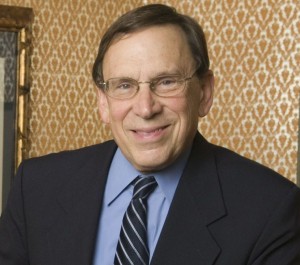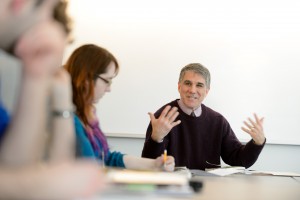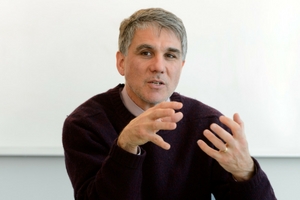 Center Direct Jeffrey Shoulson contributed to the November 2016 issue of AJS News, which focused on the topic of contingent faculty. In On Contingent Faculty, Professor Shoulson considered the role of non-tenure-track faculty in the university system and specifically within Jewish Studies programs and predicted that the reliance on contingent faculty would continue to increase as fiscal pressures persist in constraining university spending. Professor Shoulson discussed the ways contingent faculty members can be supported by their programs and departments and expressed the hope that standards of pay and benefits would rise. Read the full article here.
Center Direct Jeffrey Shoulson contributed to the November 2016 issue of AJS News, which focused on the topic of contingent faculty. In On Contingent Faculty, Professor Shoulson considered the role of non-tenure-track faculty in the university system and specifically within Jewish Studies programs and predicted that the reliance on contingent faculty would continue to increase as fiscal pressures persist in constraining university spending. Professor Shoulson discussed the ways contingent faculty members can be supported by their programs and departments and expressed the hope that standards of pay and benefits would rise. Read the full article here.
Faculty News
Professor Daniel Hershenzon Awarded Fellowship
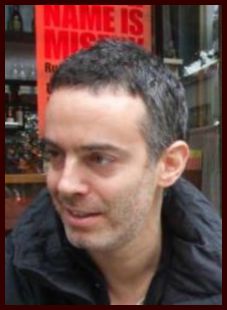 We extend our congratulations to our colleague, Daniel Hershenzon, on receiving a UCHI internal fellowship for next year. Dr. Hershenzon is an assistant professor in the department of Literatures, Cultures and Languages. His fellowship topic is: “Captivity, Commerce, and Communication: Early Modern Spain and the Mediterranean.” We look forward to learning about his research.
We extend our congratulations to our colleague, Daniel Hershenzon, on receiving a UCHI internal fellowship for next year. Dr. Hershenzon is an assistant professor in the department of Literatures, Cultures and Languages. His fellowship topic is: “Captivity, Commerce, and Communication: Early Modern Spain and the Mediterranean.” We look forward to learning about his research.
Mazel Tov!
Dr. Nehama Aschkenasy to Present Paper at Symposium
C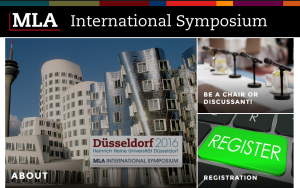 ongratulations to Dr. Nehama Aschkenasy whose paper, “Thoroughly European, Perennially an Outsider: The Hebrew Writer David Vogel (1891 -1994),” has been accepted for inclusion in the program for the Modern Language Association’s 2016 International Symposium, Other Europes: Migrations, Translations, Transformations, to be held in Düsseldorf, Germany in June 2016.
ongratulations to Dr. Nehama Aschkenasy whose paper, “Thoroughly European, Perennially an Outsider: The Hebrew Writer David Vogel (1891 -1994),” has been accepted for inclusion in the program for the Modern Language Association’s 2016 International Symposium, Other Europes: Migrations, Translations, Transformations, to be held in Düsseldorf, Germany in June 2016.
The symposium will feature approximately sixty sessions and will open with Kwame Anthony Appiah, 2016 MLA president, with Susan Neiman, director of the Einstein Forum in Potsdam, followed by a reading and reflection by the authors Eva Hoffmann, Isaac Julien, and Yoko Tawada. A distinguished and diverse group of scholars will discuss Europe’s role amidst shifting migrations.
This is the first conference hosted by the Modern Language Association (MLA) to be held outside of the United States and Canada. The conference is being organized in collaboration with the Heinrich Heine University and will be held in Düsseldorf from June 23 to 25 and is the first in a series of international symposia being held by MLA.
Course Development Grants Awarded to Three Faculty Members
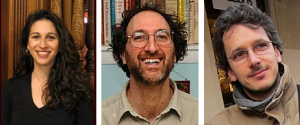
The Center for Judaic Studies and Contemporary Jewish Life invited proposals for new undergraduate course development grants in all fields, areas, and periods related to Judaic Studies. Congratulations to our successful applicants Sarah S. Willen (Assistant Professor & Director, Research Program on Global Health and Human Rights) and Richard Sosis (James Barnett Professor of Humanistic Anthropology), who will share an award and develop an anthropology course, and Andrea Celli (Assistant Professor, Italian and Mediterranean Studies), who will develop a course on Medieval Italian Literature. Grant awardees will receive $2,000 in funding to support course development.
Dr. Nehama Aschkenasy Contributes to Anthology
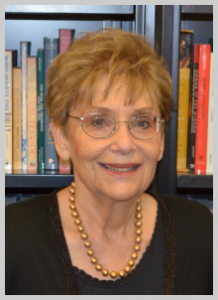 Congratulations to Dr. Nehama Aschkenasy, director of the Center for Judaic and Middle Eastern Studies at UConn, Stamford, for her recent contribution, “Reversing the Aqedah: The Biblical and the Mystical in Grossman’s ‘To the End of the Land'” in The Bible Retold by Jewish Artists, Writers, Composers, and Filmmakers, edited by Helen Leneman and Barry Dov Walfish and published by Sheffield Phoenix Press!
Congratulations to Dr. Nehama Aschkenasy, director of the Center for Judaic and Middle Eastern Studies at UConn, Stamford, for her recent contribution, “Reversing the Aqedah: The Biblical and the Mystical in Grossman’s ‘To the End of the Land'” in The Bible Retold by Jewish Artists, Writers, Composers, and Filmmakers, edited by Helen Leneman and Barry Dov Walfish and published by Sheffield Phoenix Press!
From the publisher:
Helen Leneman and Barry Dov Walfish, both specialists in biblical reception history, have compiled an unusually rich collection of new essays by experts in their fields. This book is a pioneering attempt to portray and analyse the visions of twentieth- and twenty-first century Jewish artists working in different media—visual art, literature (novels, poetry and short stories), music (opera, oratorio and song), and film—who have retold biblical narratives through their art. Reading these essays together will bring a new appreciation and understanding of what makes the perspective of these visual artists, writers, composers and filmmakers on the Hebrew Bible uniquely Jewish.
All of these Jewish visions can be considered a form of modern midrash, as the artists imaginatively fill in gaps in the biblical narrative, bringing a modern sensibility to the meanings of the stories.
Unde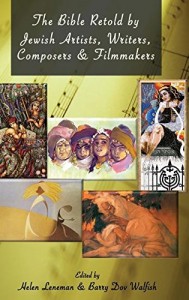 r the heading ‘Biblical Women’, the stories of the matriarchs, Hagar, and other biblical women are re-imagined in the visual arts, poetry and music. Several further chapters focus on the story of the Aqedah (Binding of Isaac), as represented in the visual arts, literature and music. Other retellings of biblical narratives through short stories are then examined, while yet other chapters explore the books of Esther and Psalms as envisioned and retold in the visual arts, opera, literature and film
r the heading ‘Biblical Women’, the stories of the matriarchs, Hagar, and other biblical women are re-imagined in the visual arts, poetry and music. Several further chapters focus on the story of the Aqedah (Binding of Isaac), as represented in the visual arts, literature and music. Other retellings of biblical narratives through short stories are then examined, while yet other chapters explore the books of Esther and Psalms as envisioned and retold in the visual arts, opera, literature and film
These retellings, analysed and discussed by the authors of this ground-breaking volume, will stimulate the reader to view the texts in new ways or to confront their challenge to personal or traditional interpretations of those texts.
Professor Dashefsky discusses the “American Jewish Year Book 2015” with the CT Jewish Ledger
The Center’s Director Emeritus, Professor Arnold Dashefsky, recently spoke with the CT Jewish Ledger about the “American Jewish Year Book 2015.”
From the article:
“We feel that we have an historic responsibility. Fifty years from now, somebody will want to know something about the Jewish population or about an organization and it’s true that you can find a lot of these things on the Internet. But as far as the infrastructure of the American Jewish community – the 400 or 500 pages that we have listing all the organizations, press, scholarly contributions, transitions in terms of the awards that people have won, and obituaries – you won’t know that 50 years from now, except if you look at the Year Book.”
To read the article, click here.
Daily Campus – “New course on Holocaust aims to ‘represent the unimaginable’ through film, theater”
The Daily Campus, UConn’s daily newspaper, published an article on October 29, 2015 detailing one of the new courses offered by the Center for Judaic Studies.
From the article:
“The course will examine how the Holocaust has been represented, and the difficulties associated with trying to portray the event successfully, Sibelman said. Students will look at written and filmed works, such as first-hand accounts, dramatic works and documentaries that successfully capture elements of the Holocaust.”
To read the article on The Daily Campus website, click here.
Upcoming Release of the American Jewish Year Book 2015 Includes New Population Study Data
The 2015 volume of the American Jewish Year Book, produced by Springer and supported by the Center for Judaic Studies and Contemporary Jewish Life at the University of Connecticut and the Center for Contemporary Judaic Studies at the University of Miami, will be released in the coming weeks. Included in the Year Book are the regular chapters on US and world Jewish population stat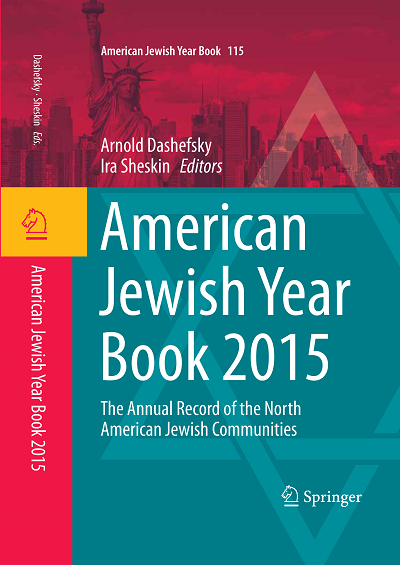 istics, this year with some surprising findings. Of note, Sergio DellaPergola, in reporting on his world Jewish population studies, argues that Israel’s Jewish population has outnumbered that of the United States, the largest Diaspora community. DellaPergola argues that Israel’s rapid Jewish population growth has overtaken the US’s more stable growth and estimates that Israel’s Jewish population has reached 6.2 million and the US population 5.7 million. However, as DellaPergola points out, “Israel’s Jewish population faces a significant demographic challenge with its gradually diminishing majority status vis-á-vis the Palestinian Arab population who live within the boundaries of the State of Israel as well as on the whole territory between the Mediterranean Sea and the Jordan River.” In fact, according to DellaPergola, the enlarged Jewish population represents a bare majority (52.1 %) of the total population living between the Mediterranean Sea and the Jordan River.
istics, this year with some surprising findings. Of note, Sergio DellaPergola, in reporting on his world Jewish population studies, argues that Israel’s Jewish population has outnumbered that of the United States, the largest Diaspora community. DellaPergola argues that Israel’s rapid Jewish population growth has overtaken the US’s more stable growth and estimates that Israel’s Jewish population has reached 6.2 million and the US population 5.7 million. However, as DellaPergola points out, “Israel’s Jewish population faces a significant demographic challenge with its gradually diminishing majority status vis-á-vis the Palestinian Arab population who live within the boundaries of the State of Israel as well as on the whole territory between the Mediterranean Sea and the Jordan River.” In fact, according to DellaPergola, the enlarged Jewish population represents a bare majority (52.1 %) of the total population living between the Mediterranean Sea and the Jordan River.
Other estimates of the Jewish population in the United States are higher, including that of Ira Sheskin and Arnold Dashefsky who, in this issue of the Year Book, estimate the figure to be closer to 6.8 million. In the chapter on US Jewish Population, Sheskin and Dashefsky examine the May 2015 Pew Study, America’s Changing Religious Landscape, which, in contrast to scholarly opinion that the US Jewish population is not increasing, reports that the adult Jewish population has increased from 1.7 to 1.9 % from 2007 to 2014. According to Sheskin and Dashefsky, “while the increase in the proportion of adult Jews from 2007 to 2014 was not statistically significant, it does suggest the likelihood of stability in the Jewish share of the adult population of the US.”
The research findings of population studies reported in the Year Book have broader implications in terms of policy and Jewish community planning. One thing that can be agreed upon, is that due to Israel’s higher fertility rates, younger Jewish population, and increased immigration, the population in Israel will continue to increase while the US Jewis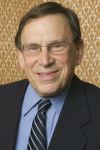 h population is expected to remain more stable due to higher intermarriage rates and an aging population.
h population is expected to remain more stable due to higher intermarriage rates and an aging population.
The Year Book, since 1899 with a brief interruption from 2008-2012, has served educators, scholars, lay leaders, and members of the Jewish community as an inestimable resource. Featuring both chapters from eminent scholars on North American Jewish life as well as extensive lists detailing the numerous North American Jewish institutions, periodicals, academic resources, and major events, the Year Book preserves an invaluable annual record of Jewish life.
Regular articles on National Affairs by Ethan Felson, joined this year by Mark Silk, and Jewish Communal Affairs by Lawrence Grossman summarize and relate yearly events. Topical articles specific to this issue include Steven Gold’s chapter on adaptation patterns of US Jewish immigrants while Annette Koren, Leonard Saxe, and Eric Fleisch examine Jewish campus life. Population studies for the United States, World Jewry, and Canada are provided by Ira Sheskin and Arnold Dashefsky, Sergio DellaPergola, and Charles Shahar, respectively.
Jeffrey Shoulson’s Podcast Interview with New Books in Jewish Studies
Professor Jeffrey Shoulson was recently interviewed about his newly published book, In Fictions of Conversion: Jews, Christians, and Cultures of Change in Early Modern England (University of Pennsylvania Press, 2013), by New Books In Jewish Studies.
Jeffrey S. Shoulson, the Doris and Simon Konover Chair in Judaic Studies and the Director of the Center for Judaic Studies and Contemporary Jewish Life at the University of Connecticut, argues that the promise and peril of conversion was projected onto the figure of the Jew, the ultimate religious “other” in English society.
Shoulson looks at English writings on religious conversion and how conversion became a means through which other “technologies of transformation” were figured. His reading of diverse texts, from the translated King James Bible to the poetry of Milton, helps us understand the ways in which the figure of the Jew could serve a variety of purposes in the early modern English imagination.
Congratulations to Stuart Miller on the publication of “At the Intersection of Texts and Material Finds”
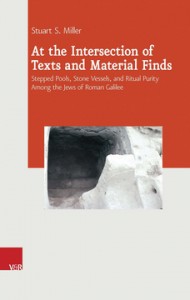 Congratulations to our colleague, Stuart Miller, on the publication of his important new study on ritual purity practices and material culture in Greco-Roman Palestine.
Congratulations to our colleague, Stuart Miller, on the publication of his important new study on ritual purity practices and material culture in Greco-Roman Palestine.
The book includes a fascinating afterward on some of the stunning continuities in those practices Stuart discovered between the ancient world and 19th century New England during his excavation of the remains of Jewish farming community in Chesterfield, CT.
Mazel Tov!
